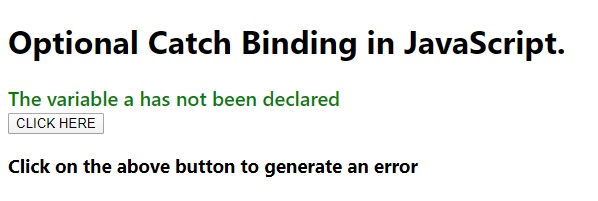
 Data Structure
Data Structure Networking
Networking RDBMS
RDBMS Operating System
Operating System Java
Java MS Excel
MS Excel iOS
iOS HTML
HTML CSS
CSS Android
Android Python
Python C Programming
C Programming C++
C++ C#
C# MongoDB
MongoDB MySQL
MySQL Javascript
Javascript PHP
PHP
- Selected Reading
- UPSC IAS Exams Notes
- Developer's Best Practices
- Questions and Answers
- Effective Resume Writing
- HR Interview Questions
- Computer Glossary
- Who is Who
Explain Optional Catch Binding in JavaScript.
The optional catch binding introduced in ES2019 allows us to remove the surrounding parentheses of a catch binding i.e. we don’t need to use a variable to store the error object. It is useful especially if we know about the error in advance or even if want to react to an error without knowing about it.
Following is the code for the optional catch binding in JavaScript −
Example
<!DOCTYPE html>
<html lang="en">
<head>
<meta charset="UTF-8" />
<meta name="viewport" content="width=device-width, initial-scale=1.0" />
<title>Document</title>
<style>
body {
font-family: "Segoe UI", Tahoma, Geneva, Verdana, sans-serif;
}
.result {
font-size: 20px;
font-weight: 500;
}
</style>
</head>
<body>
<h1>Optional Catch Binding in JavaScript.</h1>
<div style="color: green;" class="result"></div>
<button class="Btn">CLICK HERE</button>
<h3>Click on the above button to generate an error</h3>
<script>
let resEle = document.querySelector(".result");
document.querySelector(".Btn").addEventListener("click", () => {
try {
resEle.innerHTML = a;
}
catch {
resEle.innerHTML = "The variable a has not been declared";
}
});
</script>
</body>
</html>
Output
The above code will produce the following output −

On clicking the ‘CLICK HERE’ button −


Advertisements
